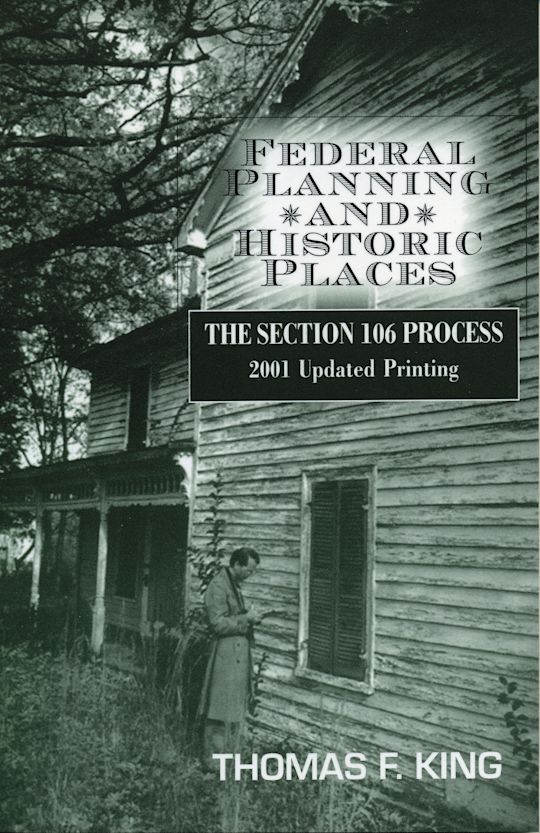- Home
- ACADEMIC
- Archaeology
- Archaeology - Other
- Federal Planning and Historic Places
Inspection copy added to basket
This title is available for inspection copy requests.
Please note our inspection copies are only available in ebook format, and are fulfilled by VitalSource™. If an ebook isn’t available, please visit our inspection copy page for more information.
Buy from Bloomsbury eTextBooks
You are now leaving the Bloomsbury Publishing website. Your eBook purchase will be with our partner https://www.vitalsource.com.
Your credit card statement will show this purchase originating from VitalSource Technologies. They will also provide any technical assistance you might require.
You must sign in to add this item to your wishlist. Please sign in or create an account
Description
Section 106. A critical section of an obscure law, the National Preservation Act. It has saved thousands of historic sites, archeological sites, buildings, and neighborhoods across the country from destruction by Federal projects. And it has let even more be destroyed, or damaged, or somehow changed. It is the major legal basis for a multi-million dollar "cultural resource management" industry that provides employment to thousands of archeologists, historians, and architectural historians. It is interpreted in a wide variety of ways by judges, lawyers, Federal agency officials, State and Tribal Historic Preservation Officers, contractors, and academics. But what does it say, and how does the regulatory process it created actually work? In this book, Tom King de-mythologizes Section 106, explaining its origins, its rationale, and the procedures that must be followed in carrying out its terms. Available just months after the latest revision of section 106, this book builds on King's best-selling work, Cultural Resource Laws and Practice: an Introductory Guide (AltaMira Press 1998). It is indispensable for federal, state, tribal, legal, academic, and citizen practitioners in the United States. King's engaging and witty prose turns a tangle of complicated regulation into a readable and engaging guide. ** CLICK 'Sample Readings' below to view the most current addendum to this book.
Sponsored by the Heritage Resources Management Program, University of Nevada, Reno
Table of Contents
Chapter 2 1. 106 of What?
Chapter 3 2. Evolution of a Process
Part 4 Two: Section 106 in the New Millennium
Chapter 5 3. What's it All About? When Does it Happen? Who Plays?
Chapter 6 4. The Game's Afoot! Initiating Review
Chapter 7 5. Finding What May be Affected
Chapter 8 6. Evaluation
Chapter 9 7. The Results of Identification and Evaluation
Chapter 10 8. Will There Be an Adverse Affect?
Chapter 11 9. Resolving Adverse Affect
Chapter 12 10. "Substituting" NEPA for Section 106
Chapter 13 11. The Rest of the Regulation
Chapter 14 12. Summary
Part 15 Three: Some Tools of the Trade
Chapter 16 13. Public Participation
Chapter 17 14. Writing a Memorandum of Agreement
Chapter 18 15. The Invented Wheels: Standard Stipulation
Part 19 Epilogue: The Future of 106
Chapter 20 Bibliography
Chapter 21 Appendix A: A Walk Through the ACHP's Archaeological Guidance
Chapter 22 Index
Product details
| Published | 22 Feb 2000 |
|---|---|
| Format | Ebook (Epub & Mobi) |
| Edition | 1st |
| Extent | 196 |
| ISBN | 9780759117242 |
| Imprint | AltaMira Press |
| Series | Heritage Resource Management Series |
| Publisher | Bloomsbury Publishing |
About the contributors
Reviews
-
Unique and valuable... the book for all who deal with Section 106 regulations to read and reread.
Thomas E. Emerson, (Illinois Transportation Archaeology Research Program, University of Illinois at Urbana-Champaign), Illinois Archaeology
-
Thomas F. King, a long-standing leader in the ever-growing and transforming field of Cultural Resource Management (CRM), has done a great service to the historic preservation community by writing this book.... Any archaeologist who works in CRM or who is responsible for teaching students about the realities of practicing archaeology in the U.S. today should own this book. AltaMira Press should be congratulated for publishing books like this one in its Heritage Resource Management Series and filling a publication void.
Michael D. Petraglia, American Antiquity
-
[King's] analogy between chronic disease and regulatory procedures is funny as well as sharp-edged .... The goal of AltaMira's Heritage series includes producing 'practical guides designed to help those who work in cultural resource management, environmental management, heritage preservation, and related subjects.' This goal has been met by King's contribution.
Susan R. Martin, Journal Of The Society For Industrial Archaeology
-
If Historical Preservation Departments across the country realize the importance of King's work, it maybe come the essential supplement to those who would assure employment to thousands of archaeologists, historians, and preservationists. And, if this happens, it may turn the tide in preserving what is important to many Americans. This is a valuable work.
J. Christopher Schnell, Southeast Missouri State University, Journal of the West
-
I would recommend King's book to students in academic programs that serve to train the next generation of historic preservation professionals.... Those of us who are professionally involved with historic preservation planning in the United States (and her trust territories that are also subject to the process) will find many, many sections of King's book to be enlightening, provocative, and interesting-and funny to boot! .... King's book, as I have said,is wonderfully insightful.
Edward L. Bell, Massachusetts Historical Commission, Northeast Historical Archaeology
-
[Tom King] very nearly manages to bring what can be a complicated and arcane process into lay terms. Laced with humor, thought-provoking (and sometimes controversial) prose, and simplified examples, Federal Planning and Historic Places should assist anyone who wishes to learn about the 106 process.
Bill Callahan, State Historic Preservation Office, NSHS, Nebraska History



































